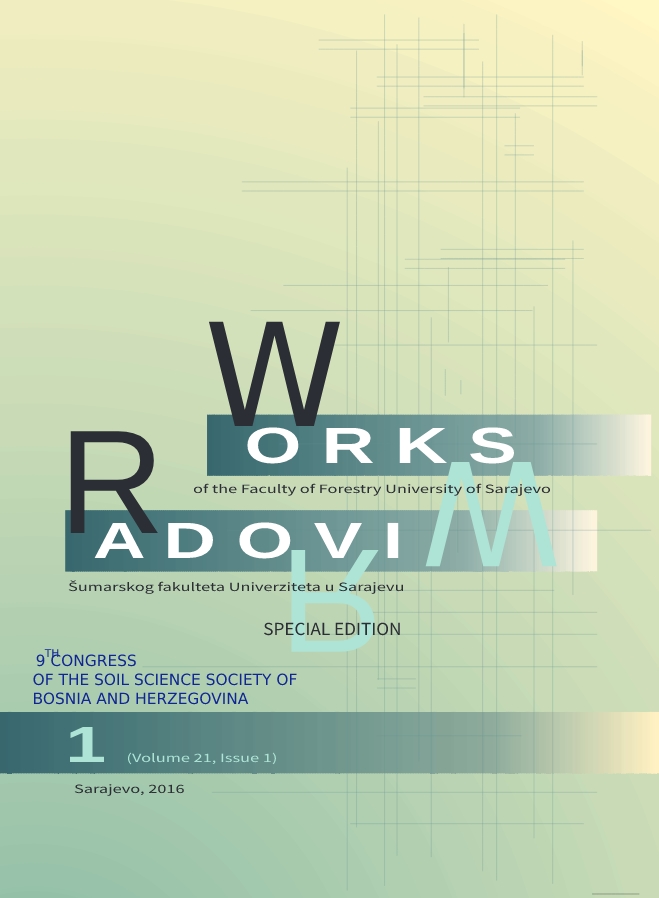PHYSICAL-CHEMICAL CHARACTERISTICS OF HERBICIDES USED FOR MAIZE PRODUCTION IN BIH AS FACTORS OF POTENTIAL HERBICIDE LEACHING IN GROUNDWATER
DOI:
https://doi.org/10.54652/rsf.2016.v1.i1.306Ključne riječi:
herbicides, leaching, indicators, risk, maizeSažetak
UDK 631.4:632.954; 633.1:632.954(497.6)
The aim of the study is to present the elements which must be considered while determining the risk of the mobility of the herbicides. Herbicides used for maize production have the special eco toxical significance and special risk because some are potentially mobile, they are used on the large surfaces during the rainy period and near rivers.
Behaviour of the herbicides in the environment, particularly in the soil is very complex. It does not depend only on the characteristics of the herbicide, but on the many factors of the environment which are very variable. Regardless of this fact, there are experimentally determined physical-chemical indicators for each herbicide that show the possible behaviour of herbicides in the environment. Studied physical-chemical indicators of herbicide behavior are: Distribution Coefficient (Kd); Organic Carbon Partitioning Coefficient (Koc); Time of the Semi-Decomposition (DT50); Water Solubility (S); Groundwater Ubiquity Score (GUS); Henry's Law Constant (Kh), Vapor Pressure (PV) and the Dissociation Constant (pKa).
Namely, herbicides, in larger or smaller measure, have “leaching potential“, which is ability to reach the underground water. One of the basic criteria for evaluating the herbicide ability to reach the underground water is related to indicators of mobility and persistency (DT50) herbicides, but neglecting some other criteria in that evaluation such as the amount of applying, characteristics of the soil and the aim of the crop growth. According to the EPA criteria, for the herbicides used in maize production in Bosnia and Herzegovina (BiH), the “trigger“ value will indirectly indicate if the herbicides have large leaching potential.
Downloads
References
Cabrera, A.; Cox, L.; Velarde, P.; Koskinen, C.W.; Cornejo, J. 2007. Fate of Diuron and Terbuthylazine in Soils Amended with Two-Phase Olive Oil Mill Waste. J. Agric. Food Chem. 55, 4828-4834.
FAOSTAT .www.faostat.org
Federal Hydrological Service. http://www.fhmzbih.gov.ba/latinica/HIDRO-WWD09.php Gustafson, D.I. 1989. Groundwater ubiquity score: a simple method for assessing
pesticide leachability. Environmental Toxicology and Chemistry 8, 339-357.
Janjić, V., Đalović, I., Mitrić, S. 2005. Behaviour and degradation in soil of herbicide inhibitor of acetolactate-synthase. Herbologija, Vol. 6, No. 1, 91-102.
Kerle, A.E., Jenkins, J.J., Vogue, A.P. 2007. Understanding pesticide persistence and mobility for groundwater and surface water protection. Oregon State University, Extension Service, EM 8561-E (http://extension.oregonstate.edu /catalog/html/ em/em8561-e/).
Paris, P.; Citro, L.; Di Carlo, E.; Maschio, G., Pace, E.; Ursino, S. 2013: Rapporto nazionale pesticidi nelle aque dati 2009-2011- Edizione 2013. ISPRA- Istituto Superiore per la Protezione e la Ricerca Ambientale (ISBN 978-88-448-0595-1), p. 1-81.
Whitford, F., Wolt, J., Nelson, H., Barrett, M., Brichford, Sarah, Turco, R. 2002. Pesticides and water quality- principles, policies, and programs. Purdue university cooperative extension service, West Lafayette, IN 47907 (https://ag.purdue.edu/ btny/Extension/Pages/PPP.aspx)
Wilson, C. 2009. Aquatic Toxicology Notes: Predicting the Fate and Effects of Aquatic and Ditchbank Herbicides. Florida Cooperative Extension Service, Institute of Food and Agricultural Sciences, University of Florida, SL236 (http://edis.ifas.ufl.edu.)























